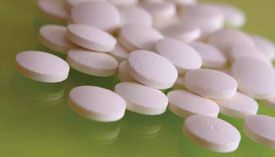Vitamin D Eases Musculoskeletal Symptoms in Breast Cancer Patients
Weekly high-dose vitamin D supplementation improves joint and muscle pain related to anastrozole therapy in breast cancer patients with low vitamin D levels.

Weekly high-dose vitamin D supplementation improves joint and muscle pain related to anastrozole therapy in breast cancer patients with low vitamin D levels, according to the results of a phase II study. Musculoskeletal symptoms are a known adverse class effect of all 3 FDA-approved adjuvant aromatase inhibitors, which include anastrozole, letrozole, and exemestane.
The data also showed that weekly supplementation with 50,000 IU of vitamin D appears to exert a favorable effect on bone health.
Antonella L. Rastelli, MD, with Washington University School of Medicine in St. Louis, Missouri, and associates randomized 60 women to 2 treatment groups.
Patients allocated to high-dose vitamin D received 50,000 IU per week of vitamin D (for 8 weeks if their baseline 25-hydroxyvitamin D [25(OH)D] level ranged from 20 to 29 ng/mL; and for 16 weeks if their 25(OH)D level ranged from 10 ng/mL to 19 ng/mL), after which they were switched to monthly vitamin D doses of 50,000 IU. A control group of patients received matching placebo.
All study participants also received 400 IU vitamin D daily, which is the current recommended vitamin D intake in adults, and 1000 mg of calcium daily.
Women enrolled in the trial had had hormone receptor-positive invasive nonmetastatic breast cancer and had completed at least 8 weeks of anastrozole as adjuvant therapy. They also reported new or worsening musculoskeletal pain that was not due to trauma.
In addition, they had serum 25(OH)D levels between 10 and 29 ng/mL, serum calcium ≤10.3 mg/dL, and 25-hour urine calcium excretion ≤250 mg/g creatinine.
Rastelli and colleagues said that aromatase inhibitor-induced musculoskeletal symptoms (AIMSS) generally include pain/ discomfort in the hands, knees, hips, lower back, shoulders, and feet, and often occur in association with stiffness. Some studies have reported that half of breast cancer patients may develop these symptoms, which have been identified as the number 1 reason why women stop aromatase inhibitor therapy prematurely. Early treatment withdrawal is “especially important” given that women with AIMSS may have a better prognosis and may be more likely to improve with aromatase inhibitor therapy than women without these symptoms, they added.
Early treatment withdrawal is ‘especially important’ given that women with aromatase inhibitor-induced musculoskeletal symptoms may have a better prognosis and may be more likely to improve with aromatase inhibitor therapy than women without these symptoms.
The primary endpoint in the study was the change from baseline in musculoskeletal pain.
At 2 months, patients assigned to high-dose vitamin D had a significant decrease in pain on the Brief Pain Inventory (P = .009) and the Fibromyalgia Impact Questionnaire (P = .01) compared with the placebo group. The vitamin D group also had significantly better scores on the Health Assessment Questionnaire—Disability Index (P = .04). The questionnaires used in the study have been widely validated for the assessment of pain and impairment.
The improvement with vitamin D supplementation was not maintained at 4 and 6 months when patients switched to 50,000 IU monthly. The researchers said that this decline may be due to the relatively short half-life and weak potency of the plant-derived vitamin D2, which is the form of vitamin D used in the vitamin D supplementation group.
When the investigators determined the effect of vitamin D supplementation on bone loss at 6 months, bone mineral density (BMD) of the femoral neck appeared to be preserved in the vitamin D group, whereas the placebo group had a loss in bone mass. The difference between the 2 groups tended toward statistical significance.
The authors pointed out that vitamin D’s favorable effect on BMD at the femoral neck may reflect increased mineralization of bone matrix from improved calcium absorption. Vitamin D may also possibly work by regulating intact parathyroid hormone levels.
Because 4 (14%) patients in the vitamin D group developed abnormally high 24-hour urinary calcium excretion and had to drop out of the study, Rastelli and colleagues recommended periodic monitoring of urine calcium in patients on high-dose vitamin D for AIMSS.
They emphasized that more research is needed to determine the optimal strategy for vitamin D supplementation in postmenopausal women with early breast cancer and AIMSS.
Rastelli AL, Taylor ME, Gao F, et al. Vitamin D and aromatase inhibitor-induced musculoskeletal symptoms (AIMSS): a phase II, double-blind, placebo-controlled, randomized trial [published online ahead of print June 21, 2011]. Breast Cancer Res Treat. 2011;129(1):107-116.




